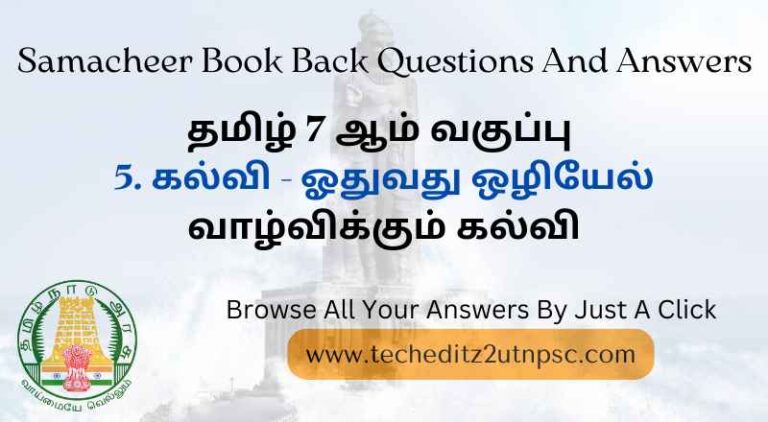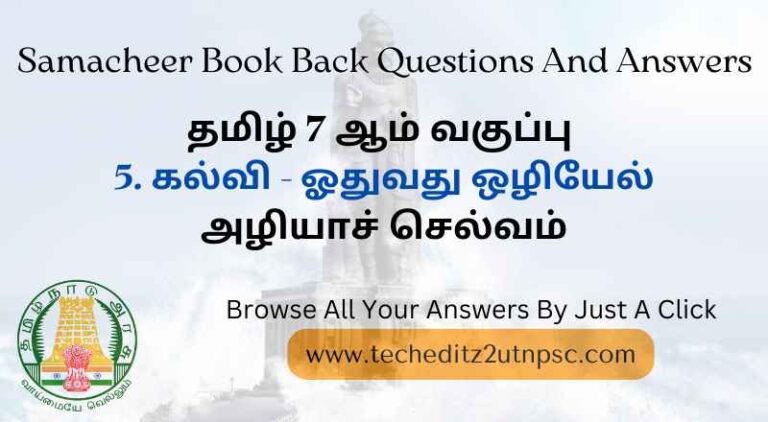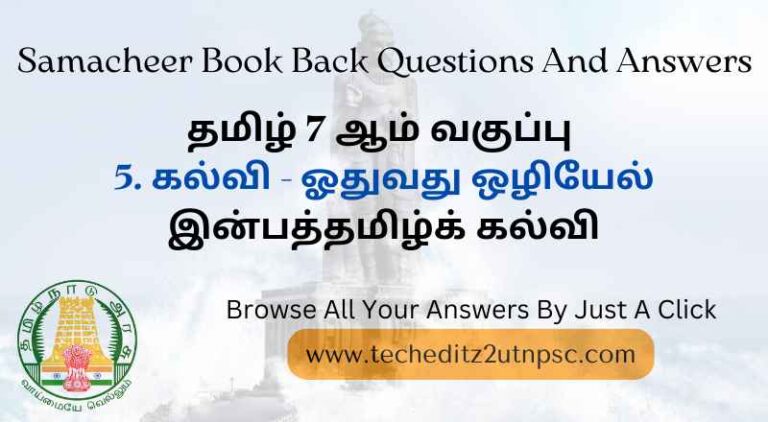support@techeditz2utnpsc.com | 8300-921-521

Laws of Motion
Samacheer Book Back Questions And Answers For Science Standard 10 “Laws of Motion“
I. Choose the correct answer:
1) Inertia of a body depends on
a) weight of the object
b) acceleration due to gravity of the planet
c) mass of the object
d) Both a & b
2) Impulse is equals to
a) rate of change of momentum
b) rate of force and time
c) change of momentum
d) rate of change of mas
3) Newton’s III law is applicable
a) for a body is at rest
b) for a body in motion
c) both a & b
d) only for bodies with equal masses
4) Plotting a graph for momentum on the X-axis and time on Y-axis. slope of momentum-time graph gives
a) Impulsive force
b) Acceleration
c) Force
d) Rate of force
5) In which of the following sport the turning of effect of force used
a) swimming
b) tennis
c) cycling
d) hockey
6) The unit of ‘g’ is m s-2. It can be also expressed as
a) cm s-1
b) N kg-1
c) N m2 kg-1
d) cm2 s-2
7) One kilogram force equals to
a) 9.8 dyne
b) 9.8 × 104 N
c) 98 × 104 dyne
d) 980 dyne
8) The mass of a body is measured on planet Earth as M kg. When it is taken to a planet of radius half that of the Earth then its value will be _____ kg
a) 4 M
b) 2M
c) M/4
d) M
9) If the Earth shrinks to 50% of its real radius its mass remaining the same, the weight of a body on the Earth will
a) decrease by 50%
b) increase by 50%
c) decrease by 25%
d) increase by 300%
10) To project the rockets which of the following principle(s) is /(are) required?
a) Newton’s third law of motion
b) Newton’s law of gravitation
c) law of conservation of linear momentum
d) both a and c
II. Fill in the blanks:
1. To produce a displacement _____ is required
2. Passengers lean forward when sudden brake is applied in a moving vehicle. This can be explained by _____.
3. By convention, the clockwise moments are taken as _____ and the anticlockwise moments are taken as _____.
4. _____ is used to change the speed of car.
5. A man of mass 100 kg has a weight of _____ at the surface of the Earth
Answers:
1. force
2. inertia of motion
3. negative, positive
4. Gear
5. 980 N
III. State whether the following statements are true or false. Correct the statement if it is false:
1. The linear momentum of a system of particles is always conserved.
2. Apparent weight of a person is always equal to his actual weight.
3. Weight of a body is greater at the equator and less at the polar region.
4. Turning a nut with a spanner having a short handle is so easy than one with a long handle. –
5. There is no gravity in the orbiting space station around the Earth. So the astronauts feel weightlessness. – False
Answers:
1. False (The linear momentum of a system of particle is not always conserved)
2. False (Apparent weight and actual weight can be greater or lesser)
3. False (Weight of the body is less at equator, more at polar region)
4. False (Turning a nut with a spanner having a short handle is not so easy)
5. False (Under free fall condition both astronaut and space station are in the state of weightlessness)
IV. Match the following:
1. Newton’s I law A. propulsion of a rocket
2. Newton’s II law B. Stable equilibrium of a body
3. Newton’s III law C. Law of force
4. Law of conservation of Linear momentum D. Flying nature of bird
Answers:
1. B
2. C
3. D
4. A
V. Assertion & Reasoning:
1. Assertion: The sum of the clockwise moments is equal to the sum of the anticlockwise moments.
Reason: The principle of conservation of momentum is valid if the external force on the system is zero.
a) If both the assertion and the reason are true and the reason is the correct explanation of assertion.
b) If both the assertion and the reason are true, but the reason is not the correct explanation of the assertion.
c) Assertion is true, but the reason is false.
d) Assertion is false, but the reason is true.
2. Assertion: The value of ‘g’ decreases as height and depth increases from the surface of the Earth.
Reason: ‘g’ depends on the mass of the object and the Earth.
a) If both the assertion and the reason are true and the reason is the correct explanation of assertion.
b) If both the assertion and the reason are true, but the reason is not the correct explanation of the assertion.
c) Assertion is true, but the reason is false.
d) Assertion is false, but the reason is true.
Visit Our YouTube Channel For More Free Videos: Click Here


